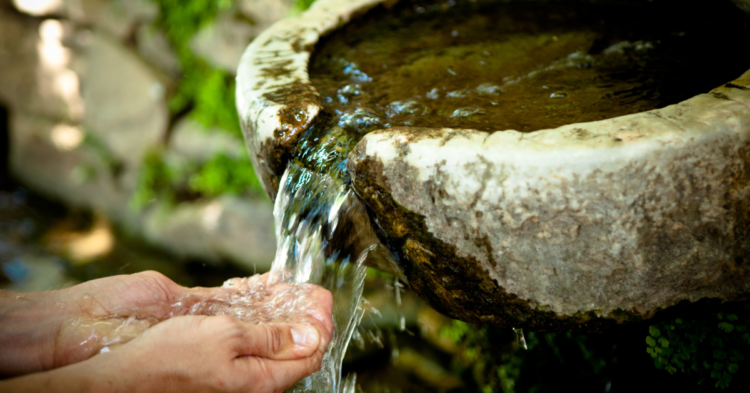Spring water:
Using Springs for Drinking Water?
Many people are fascinated by springs. The very word seems to have some magic. While springs may seem like an ideal water supply, they need to be selected with care, developed properly, and tested periodically for contamination.
A spring is a place on the earth’s surface where groundwater emerges naturally. The water source of most springs is rainfall that seeps into the ground uphill from the spring outlet. While springs may seem like an ideal water supply, they need to be selected with care, developed properly, and tested periodically for contamination.
Spring water moves downhill through soil or cracks in rock until it is forced out of the ground by natural pressure. The amount, or yield, of available water form springs may vary with the time of year and rainfall. Groundwater obtained from springs is similar to water pumped from shallow wells. Like shallow wells, springs may be contaminated by surface water or other sources on or below the ground surface.
Springs are susceptible to contamination because the water feeding them typically flows through the ground for only a short distance, limiting the amount of natural filtering that can occur. Springs may not be a good choice for a water supply if the area uphill where the water collects is used for industry, agriculture, or other potential sources of pollution.
Spring Water Protection
Springs are susceptible to contamination by surface water, especially during rainstorms. Contamination sources include livestock, wildlife, crop fields, forestry activities, septic systems, and fuel tanks located upslope from the spring outlet. Changes in color, taste, odor, or flow rate indicate possible contamination by surface water. To protect springs you can take the following measures.
- Divert all surface water away from the spring as far as possible. Do no allow flooding near the spring.
- Construct a U-shaped surface drainage diversion ditch or an earth berm at least 50 feet uphill from the spring to divert any surface runoff away from the spring. Be careful not to dig deep enough to uncover flowing groundwater. Prevent pounding in the diversion ditch.
- Construct an earth berm adjacent to the spring or a second U-shaped diversion ditch lined with concrete tile for added protection.
- Fence an area at least 100 feet in all directions around the spring box to prevent contamination by animals and people who are unaware of the spring’s location.
- Avoid heavy vehicle traffic over the uphill water bearing layer to prevent compaction that may reduce water flow.
Water Testing: Most spring contamination results from direct flow of surface water into the shallow groundwater feeding the spring. Spring water should be tested before and after heavy rains each year for bacteria, pH, turbidity, and conductivity to determine if surface-water contamination is a problem. If water levels change frequently when it rains, the spring is very susceptible to contamination. If bacteria are found at any time in the water, properly disinfect the system and retest the water before using it again.
Springs are susceptible to contamination by Giardia, cryptosporidium, and other microorganisms that are not detected by standard bacterial tests. Test for these microorganisms if spring water is suspected as a source of illness.
Excerpt From: Protecting Water Supply Springs
Prepared by: Gregory D. Jennings Extension Agricultural Engineering
Published by: North Carolina Cooperative Extension Service Publication Number: AG 473-15 Last Electronic Revision: March 1996 (JWM)

